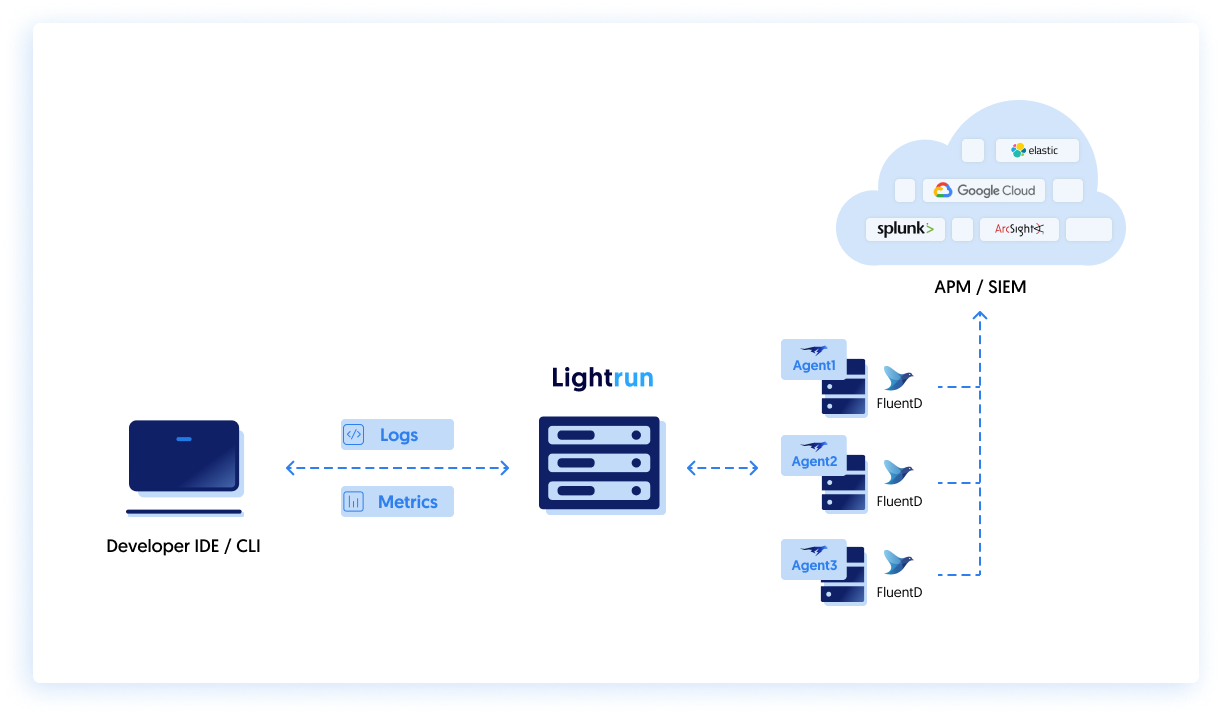Integrate Lightrun with FluentD¶
Permissions
Only users with ROLE_MANAGER permissions can perform these actions.
FluentD unified logging layer is an open source CNFC project, that may be used as a Lightrun logs collector. It can also be used as a parser, for logs enrichment, for data anonymization and also as a forwarder to variety of APMs and SIEMs (such as Splunk, Elastic, Datadog, ArcSight, etc...).
Topology and overview¶
Let's take a look at the topology of running Lightrun with FluentD with the intent of forwarding Lightrun logs to a sink (i.e. an APM, SIEM, etc...).

Before you begin, make sure you have installed the FluentD service and it is running on the relevant machine (i.e. where your application is running).
Configuration¶
The FluentD configuration is stored in a simple YAML file , structured as a chain of directives:
input source > parsing > filtering (optional) > output destination
In the example below, we demonstrate a common scenario where Lightrun logs are written into /tmp/lightrun_file_handler_logs1.log. In order to collect the logs we'll tail the file in our FluentD Configuration file:
<source>
@type tail
path /tmp/lightrun_file_handler_logs1.log
pos_file /var/tmp/posfile_lightrun.pos
We'll also make sure to add a tag called lightrun_log for easier identification:
tag lightrun_log
<parse>
@type none
</parse>
</source>
We'll then write the output of that parsing directive to /example/lightrun directory:
<store>
@type file
path /example/lightrun
Which simulated the piping to a remote location (but in practice writes to a local file).
In a real word scenario you might consider forwarding the logs to an APM or archive the data in an external datastore such as AWS S3 bucket. This is out of scope for this article, but can be easilty done using FluentD's various output plugins.
The full configuration example:
<source>
@type tail
path /tmp/lightrun_file_handler_logs1.log
pos_file /var/tmp/posfile_lightrun.pos
tag lightrun_log
<parse>
@type none
</parse>
</source>
<match lightrun_log>
@type copy
<store>
@type file
path /example/lightrun
<buffer>
chunk_limit_size 512K
flush_interval 15s
flush_thread_count 8
</buffer>
</store>
</match>
Output Example¶
Applying the above configuration will create a log file in the /example/lightrun directory with the following structure:
2021-10-28T15:34:10+00:00 lightrun_log {"message":"<record>"}
2021-10-28T15:34:10+00:00 lightrun_log {"message":" <date>2021-10-28T15:34:00.663749Z</date>"}
2021-10-28T15:34:10+00:00 lightrun_log {"message":" <millis>1635435240663</millis>"}
2021-10-28T15:34:10+00:00 lightrun_log {"message":" <nanos>749000</nanos>"}
2021-10-28T15:34:10+00:00 lightrun_log {"message":" <sequence>11962</sequence>"}
2021-10-28T15:34:10+00:00 lightrun_log {"message":" <level>INFO</level>"}
2021-10-28T15:34:10+00:00 lightrun_log {"message":" <class>PrimeMainMR</class>"}
2021-10-28T15:34:10+00:00 lightrun_log {"message":" <method>isPrime</method>"}
2021-10-28T15:34:10+00:00 lightrun_log {"message":" <thread>1</thread>"}
2021-10-28T15:34:10+00:00 lightrun_log {"message":" <message>LOGPOINT: lightrun TEST log</message>"}
2021-10-28T15:34:10+00:00 lightrun_log {"message":"</record>"}
2021-10-28T15:34:10+00:00 lightrun_log {"message":"<record>"}